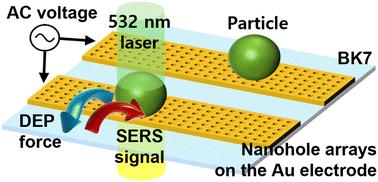Our official English website, www.x-mol.net, welcomes your
feedback! (Note: you will need to create a separate account there.)
Surface-enhanced Raman spectroscopy with single cell manipulation by microfluidic dielectrophoresis
Analyst ( IF 3.6 ) Pub Date : 2024-10-16 , DOI: 10.1039/d4an00983e Kwanhwi Ko, Hajun Yoo, Sangheon Han, Won Seok Chang, Donghyun Kim
Analyst ( IF 3.6 ) Pub Date : 2024-10-16 , DOI: 10.1039/d4an00983e Kwanhwi Ko, Hajun Yoo, Sangheon Han, Won Seok Chang, Donghyun Kim

|
When exposed to an alternating current (AC) electric field, a polarized microparticle is moved by the interaction between the voltage-induced dipoles and the AC electric field under dielectrophoresis (DEP). The DEP force is widely used for manipulation of microparticles in diverse practical applications such as 3D manipulation, sorting, transfer, and separation of various particles such as living cells. In this study, we propose the integration of surface-enhanced Raman spectroscopy (SERS), an extremely sensitive and versatile technique based on the Raman scattering of molecules supported by nanostructured materials, with DEP using a microfluidic device. The microfluidic device combines microelectrodes with gold nanohole arrays to characterize the electrophysiological and biochemical properties of biological cells. The movement of particles, which varies depending on the electrical properties such as conductivity and permittivity of particles, can be manipulated by the cross-frequency change. For proof of concept, Raman spectroscopy using the DEP–SERS integration was performed for polystyrene beads and biological cells and resulted in an improved signal-to-noise ratio by determining the direction of the DEP force applied to the cells with respect to the applied AC power and collecting them on the nanohole arrays. The result illustrates the potential of the concept for simultaneously examining the electrical and biochemical properties of diverse chemical and biological microparticles in the microfluidic environment.
中文翻译:

通过微流体介电泳进行单细胞操作的表面增强拉曼光谱
当暴露于交流 (AC) 电场时,极化微粒在介电泳 (DEP) 下通过电压感应偶极子和交流电场之间的相互作用而移动。DEP Force 广泛用于各种实际应用中的微粒操作,例如 3D 操作、分拣、转移和分离各种颗粒(如活细胞)。在这项研究中,我们提出了表面增强拉曼光谱 (SERS) 与使用微流体设备的 DEP 的集成,SERS是一种基于纳米结构材料支持的分子拉曼散射的极其灵敏和多功能的技术。微流控装置将微电极与金纳米空穴阵列相结合,以表征生物细胞的电生理和生化特性。粒子的运动取决于粒子的电导率和介电常数等电特性,可以通过交叉频率变化来控制。为了验证概念,使用 DEP-SERS 积分对聚苯乙烯珠和生物细胞进行了拉曼光谱分析,通过确定施加在细胞上的 DEP 力相对于施加的交流功率的方向并将其收集在纳米空穴阵列上,从而提高了信噪比。该结果说明了该概念在微流体环境中同时检查各种化学和生物微粒的电学和生化特性的潜力。
更新日期:2024-10-16
中文翻译:

通过微流体介电泳进行单细胞操作的表面增强拉曼光谱
当暴露于交流 (AC) 电场时,极化微粒在介电泳 (DEP) 下通过电压感应偶极子和交流电场之间的相互作用而移动。DEP Force 广泛用于各种实际应用中的微粒操作,例如 3D 操作、分拣、转移和分离各种颗粒(如活细胞)。在这项研究中,我们提出了表面增强拉曼光谱 (SERS) 与使用微流体设备的 DEP 的集成,SERS是一种基于纳米结构材料支持的分子拉曼散射的极其灵敏和多功能的技术。微流控装置将微电极与金纳米空穴阵列相结合,以表征生物细胞的电生理和生化特性。粒子的运动取决于粒子的电导率和介电常数等电特性,可以通过交叉频率变化来控制。为了验证概念,使用 DEP-SERS 积分对聚苯乙烯珠和生物细胞进行了拉曼光谱分析,通过确定施加在细胞上的 DEP 力相对于施加的交流功率的方向并将其收集在纳米空穴阵列上,从而提高了信噪比。该结果说明了该概念在微流体环境中同时检查各种化学和生物微粒的电学和生化特性的潜力。


















































 京公网安备 11010802027423号
京公网安备 11010802027423号